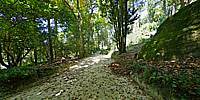© 2013 Andrew Varlamov, All Rights Reserved.
Rejecting the formal austerity of the classical gardens and taking into account the uneven grounds, the fertility of the soil, the climatic singularity of the mountain and the effect of the horizons, D. Fernando II designed the park in such a way that it would appear to be natural and in keeping with the surroundings. Just as he indulged in his architectural fantasies when he designed the Pena Palace, he took his inspiration from opera sets and faraway landscapes, for the park, imagining different contrasting atmospheres with unusual and exotic features.
In order to achieve his idea, he incorporated the vestiges left by the Hieronymus monks, just as he had done in the palace.
He designed lakes connected with waterfalls and, for the forests and woods of his imagination, he imported species of plants which were characteristic of different places in the world – cryptomerias from Japan, ferns from New Zealand, cedars from Lebanon, araucarias from Brazil and arbors vitae from North America, planted side by side with Portuguese plants, in a total of over two thousand species.
D. Fernando II also had pavilions in various architectural styles, fountains, springs, nooks and belvedere built throughout the park.
Plate near the tree contains the next inscription:
Ocotea foetens (Aiton) Baill.
LAURACEAE
Til, Madeira Stinkwood
Endemic to Madeira and the Canary Islands
Tree approx. 36 m in height. Fruit is partially enclosed by the cup-shaped perianth.
An old specimen that survived the cyclone of 1941. Probably introduced to the Pena Park in the 1920s or 30s by the forester, Oliveira Carvalho.
The specific epithet foetens means "stinking" and derives from the unpleasant odour emitted by the wood when sawn.
The high-quality timber from young trees is white, whilst that from mature specimens is black.
Parques de Sintra
Monte da Lua
Lat: 38° 47' 8.88" N
Long: 10° 24' 28.32" W
Precision is: Medium. Nearby, but not to the last decimal.
Lens: smc PENTAX-DA Fish-Eye 1:3.5-4.5 10-17mm ED (IF)
Tripod: BENRO A-058
Panohead: Nodal Ninja 5
PC Software: PTGui Pro 9.1.8 by New House Internet Services B.V. (dated by August 10, 2013), Pano2QTVR Pro Flash version 1.6.6 by Thomas Rauscher



 Tap or click the zoom icon in the bottom right corner of the picture to switch between in-page and fullscreen view
Tap or click the zoom icon in the bottom right corner of the picture to switch between in-page and fullscreen view